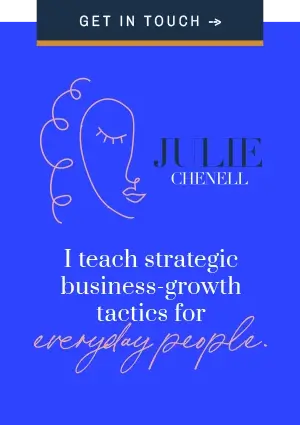In this episode, I go into the key planning strategy I’m using to celebrate 2018 and plan for the new year!
Subscribe On:
Full Transcript:
Hey everyone, this is Julie. Happy Day. We are like, I don’t know what it is, like five or six days before Christmas. I hope you’re doing amazing today. I want to talk about end of year New Year’s planning in your business, especially when you have a laptop life.
All right, so you know, one of the things that I think is a great exercise to do. Obviously you can do this every month, every quarter, but especially at the end of the year is to look back and create a list of all the things that you’ve accomplished over the year and I know that in business, you know, revenue is sort of the king, but there are other numbers that can really help not just provide insight into what you’ve done this year, but also give you momentum into the next year. So one of the numbers actually want to give a shout out to Alex Charfen who taught this to me originally. He has the Momentum podcast and he talks about a critical number in your business. Russell Brunson, owner of Clickfunnels. He talks about this too. He talks about that key metric, that key key performance indicator and what they’re both essentially saying is that there is usually one number in your business to rule all the other numbers.
It is the driving force number in your business and it’s not revenue, believe it or not. And it’s not even profit. It’s actually the number that communicates best, the change you’re making in the world with your business. So let me give you an example, I have a client, he’s in my, in my inner circle and he helps train up firefighters to be leaders and he was trying to figure out what is his critical number, is it revenue, is it customers, new customers? And I said, you know, it is both of those things, but what it really is, is the change that you want to make in the world is that you want to affect as many stations in the United States as possible so that they all, all the firehouses in the stations have a leader, right? A firefighter who’s really calling the team to be a better version of themselves.
So I said the critical number for you is how many stations, fire stations in the United States are you going to affect in 2019? That number for him communicates so much more than just revenue, right? It communicates, okay that I’m having an effect in this area. It does mean that he’s got somebody in that firehouse, maybe one or two or more people who are actually customers, which means revenue, right? And so that becomes his critical number over a ClickFunnels where I currently spend the majority of my time right now, we have a critical number too. Our critical number is new Funnel Hackers, right? The people who come into our world and who realized, oh my gosh, funnels are the way that I need to communicate my message and change the world in my business. And so they sign up for ClickFunnels. They become Funnel Hackers, right?
That is the identifying factor and that has all kinds of trickle effects and customer base revenue, profit, etc. So when you’re doing your review for 2018, think about how many leads you got, how many customers you got, but what that actual, that number of customers, what it actually means in terms of impact and see if you can come up with a critical number that is easy to understand and is a number that drives all the other numbers in your business. So that would be a step one. Step two is, you know, when ever I forecast, I’m not a huge planner, believe it or not, I mean I like to plan, but I can’t, it’s hard for me to plan like a year out it, it just is. I can plan a year out for like high level ideas, so I take a piece of paper and I just literally spit ball what are some things that I want to see happen in the new year, high level objectives.
So then once you’ve done that, you can kind of sectioned them off into four distinct groups, right? Quarter one, quarter two, quarter three, quarter four. And you’ll notice when you have objectives, you may want to categorize your objectives because, you know, you may, this may be a perfect example, you’re a course creator, let’s say, and you’re like, I want to launch a new course. I want to build a sales funnel for this other course I have over here. I want to host my first live event and I want to get a Facebook live show going, right? Those are like several different objectives. Maybe you also want to hire somebody and you want a fix your onboarding flow for your new clients. All of those objectives are great yearly objectives, but you’ll notice that they all fall into categories, right? You’ve got a marketing objective, sales objective, operations objective, product development objective, okay.
Anything related to social media, your Facebook Live show, your funnels would be under marketing, anything related to a sales team or any sort of strategic relationships, affiliate programs, referrals, et cetera related to increasing more sales would be under your sales category. Anything related to hiring systems, onboarding, that would be under your operations category, product development would be under, that would be anything that you’re creating, right? Any actual content you’re creating, et cetera, et cetera. And events. Sometimes events straddled two objectives. They straddle marketing and they straddle, product development, right? because an event can be a product in and of itself. So you look at all your objectives and kind of categorize them. You, it’s nice when you can make sure you have a yearly objective for all those five stages, marketing, sales, operations, and product development. And of course now I can’t remember what the other one was, so I’m going to see if I can go find it while I’m doing this podcast.
Once you have them, section them out. So that if you look at the marketing objective, let’s say it’s a Facebook live show, right? That’s like your year objective. You want to have that done this year. How would you cut that up into four key milestones, right? Quarter one, quarter two, quarter three, quarter four. That would be my thought to you is like, if it’s an objective, right? And it’s a yearly objective, you want to make sure that you are not just being like, oh, on my to do list, write a book, right? I see that all the time. It’s like, no, actually quarter one maybe is the writing. Quarter two might be the editing and proofing quarter three might be planning the launch and quarter four might be launching. That’s how you take an annual objective and you slice it up into four pieces.
I found it, by the way, as I’m multitasking, the fifth department is fulfillment. So it’s marketing, sales, fulfillment, product development, operations, fulfillment is really like your customer service journey, refunds, how you deal with all that. If you’re a service based business, a, your fulfillment is the actual coaching piece, right? Or the consulting piece that you’re doing. Alright, so you take your objectives, you chunk them out into four milestones and it’s nice to have an annual objective in all five of those key business categories. Once you’ve done that, I would say that you want to. Anything that you’ve had slated for quarter two, quarter three, quarter four, just put to the side, right? Because it’s overwhelming to think about the entire year. You’ve done the, you’ve done the high level annual stuff and you’ve kind of chunked it out into four quarters. But I would just take quarter one and I would take all the whatever key objectives you had for quarter one for those five categories.
And then I would break them out month by month. I can’t get. It’s hard for me to get more granular than month by month. Although I know some people, they go month to week to day. That’s a lot of work for me and I don’t work that way so I don’t do it, but I do think, okay, what are the, what are the key things that have to happen in January, February, and then march, and then what you can do is look at that and that becomes what you do that that becomes your roadmap for the new year. So I would recommend that you number one, go after what that critical number is in your business, that key performance indicator that’s going to drive all the numbers, celebrate what you’ve done this year because I’m sure that you are, even if you’re not as far along or you didn’t hit the goals you wanted to hit, there are so many things that you’ve learned along the way.
And don’t just measure leads, customers revenue and profit and measure skills and connections, relationship capital, okay. All of those things. And then plan out the objectives in the five key areas, your business marketing, sales, fulfillment, product development and operations. Chunk amount into four quarters. Put the rest on the side and focus on that quarter one. That’s my best advice I can give you for how to plan for the new year. I hope you guys have a very, very merry Christmas and an amazing new year. I’m going to try to get a couple more podcasts in before the end of 2018. I have a lot of really cool and exciting things to share with you. I’ve been sitting on them for awhile. It’s just going to have to sit on them a little bit longer, but I hope and I thank you of course for listening and if you liked this podcast and you want me to be motivated to record more because I’m kind of slows a leave a review or share on social media and tag me. I’m appreciate you all. Talk to you soon. Thanks. Bye. If you’re ready to create growth scale your online business, you can go to www.createyourlaptoplife.com/podcast and get a free plan and how you can get started today.









0 Comments